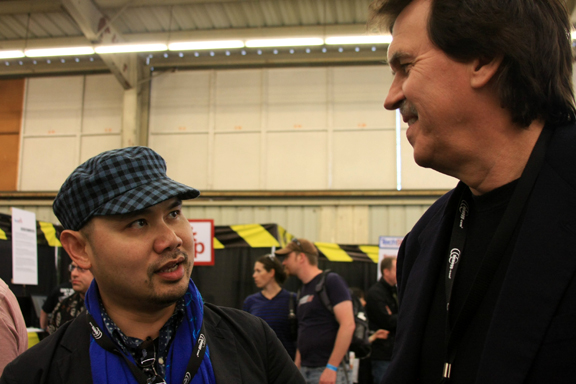|
|
Desktop Engineering Features Alibre by Kenneth Wong
By Kenneth Wong,
Desktop Engineering
Thinker, Tailor, Soldier, Maker: Snapshots
from Maker Faire Bay Area

On Saturday May 22, as midday approached at
Maker Faire Bay
Area, I was frantically trying to reach Paul Grayson, CEO of
Alibre. It was 30
minutes past our appointment. He was somewhere in that swelling tide of
people (estimated 90,000), rolling through 48 acres of fairground.
His PR firm has provided me with his
cell phone number and his booth number, but neither was of much help. When I
got a hold of him on the phone, his voice was drowned out by the sound of
whirling gadgets and buzzing electronics. The map that came with the show
guide didn’t include booth numbers. I was about to give up when I stumbled
on him in the press room, giving an interview to a reporter.
Maker Faire, an annual event organized by editors of
Make magazine (”Makezine”
for those in the know), attracts the do-it-yourself types with a knack for
arts, crafts, and science. Know how to put together an autonomous robot that
tosses balls? Want to learn how to turn your old cigar box into a mandolin?
Have a solely-for-pleasure engineering project you want to showcase? This is
where you might come to teach, learn, or share.
The maker-tinkerer phenomenon, one of the cornerstones of American
entrepreneurship, is as old as the country itself. It gave us Alexander
Graham Bell, Henry Ford, Steve Jobs, and Bill Gates, among others. What’s
new is the fast-growing maker communities, fueled by the rise of social
media and the plunging cost of technology.
For engineering software developers like Grayson, this is a few field of
opportunity, with plenty or unclaimed pastures and prairies. With a 3D
modeling package selling for $99 (less than the price of an iPod Nano),
Grayson believes his product has an advantage over Autodesk, SolidWorks, and
other big names among this exploratory, hobbyist crowd. That’s why the
six-foot-tall Texan (one of the few donning a dark suit at the fair) is
marching down the aisles, rubbing shoulders with DJs who transformed their
music into psychedelic colors, a Burning Man crowd that reprised their
pyrotechnic centipede, and a composer who automated a traditional Indonesian
orchestra (the contraption is dubbed The Gamelatron).
Personal CAD
Two days before he flew down to California for the fair, Grayson had his PR
people issue an announcement. “Alibre announces Alibre Personal Edition, for
entrepreneurs and inventors at Maker Faire.” It’s meant as “an
industrial-strength, parametric solid modeling system with integrated 3D
solid modeling, part and assembly design, associative 2D drafting, and STL
export, all at a hobby-friendly price.”
“We want to make it possible for ordinary humans to make things,” proclaimed
Grayson. “And that’s really what Maker Faire is all about. Of course, we’re
focused on a particular type of things — mechanical products that’s precise,
need to be manufactured.”
People who routinely use CAD programs are no stranger to Alibre. Last year,
Grayson stirred the engineering software community by
slashing its software’s price from $999 to $99. The Personal Edition is
what Alibre has been selling for $99 first, later for $97, then back again
for $99.
So why negotiate the $3 difference? Grayson admitted, “I’m kind of a crazy
marketing guy at heart. I try things. Sometimes my own staff get mad at me
because I keep changing it. But it’s part of my nature to want to try new
things, experiment, and see how people would react to it.”
In the past, average people couldn’t afford to cut, finish, and assemble
their own custom robots, because manufacturing facilities weren’t (they
still aren’t) designed to cater to tinkerers looking for a low-volume
production run. But today, with an affordable 3D modeling package, you could
export your design as an STL file and print it (yes, print it in 3D) at a
service bureau. The same workflow has spawned a viable industry revolving
around printing customized avatars (from such online games as World of
Warcraft or Second Life).
The contents of all photos, graphics, and text are protected by copyright
and may not be used or reproduced without prior express written authorization from the
publisher.
|

